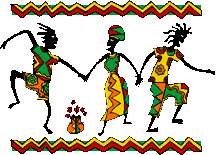|
AFRICAN TRADE ROUTES
 Trade routes developed across Africa in
several places. Early African people lived in small family
groups. Parents, children and grandparents formed clans with
other families. Larger clans became tribes. Trade routes developed across Africa in
several places. Early African people lived in small family
groups. Parents, children and grandparents formed clans with
other families. Larger clans became tribes.
Sometimes the tribe was nomadic and
traveled with their animals to the best places to graze and
drink. Other tribes settled villages, towns and sometimes
cities. Between these towns, trade routes developed. Some
routes were over land; others were traveled by river or sea.
People traveled on routes across North
Africa when the great Sahara desert was still a wet region.
When the land dried and no longer produced crops, overland
trading became very difficult. Although people had pack
animals, such as cattle horse, and oxen, travel was not easy.
These animals could not journey the great distance between
each oasis.
In about 300 AD, the Arabian camel was brought to Africa and
became the “ship of the desert.” The camel stores fat in its
hump and water in its stomach, which allows it to travel up to
ten days without fresh water—twice the distance of an ox or a
horse. All of a sudden trade was much more dependable.
They traded crops, such as salt, spices, rice, wheat, barley,
millet, olives, yams, and sorghum. Goats, fish, cattle, and
fowl were some of the livestock bought and sold. People also
traded copper, bronze, iron and gold. The metals were useful
for making tools, coins, decorations, and weapons.
Each tribe had its wise elders and
priests. Many were women but most were men. They would lead
the tribe, and if they grew very powerful they were considered
kings or queens. People considered them related to the gods.
They often organized the building of religious temples and
dams and assembled armies to defend their families. Their
subjects often paid taxes to pay for these things.
Although some of these kingdoms did not last long and were
replaced by others, a few lasted thousands of years. The rule
of one king’s family for several generations is called a
dynasty. There have been a few African kingdoms that have
extended for several dynasties. As other cultures began to
grow strong all over the Mediterranean other kingdoms began to
push their way into Africa. Small tribes grouped together to
fight off the invaders, such as the Greeks, Phoenicians, and
Romans.
Major African Kingdoms:
West: Ghana, Benin, Bornu, Songhay and Takrur (clickable
feature)
North: Mauritania, Tripolitania, Cyrenaica, Egypt, and Cush
East: Ethiopia, Bunyoro, Aksum, Buganda, Rwanda, Bemba and
Loba
South: Lesotho, Zulu; Tswana, Swazi, Shona and Mbundu
African peoples could be as different from each other as they
were to people far away in Greece, India, or Arabic countries
in Asia, just across the Red Sea. Their religious gods,
temples, beliefs and cultures were unique. Sometimes they
traded peacefully. Other times they fought for territory in
wars.
|